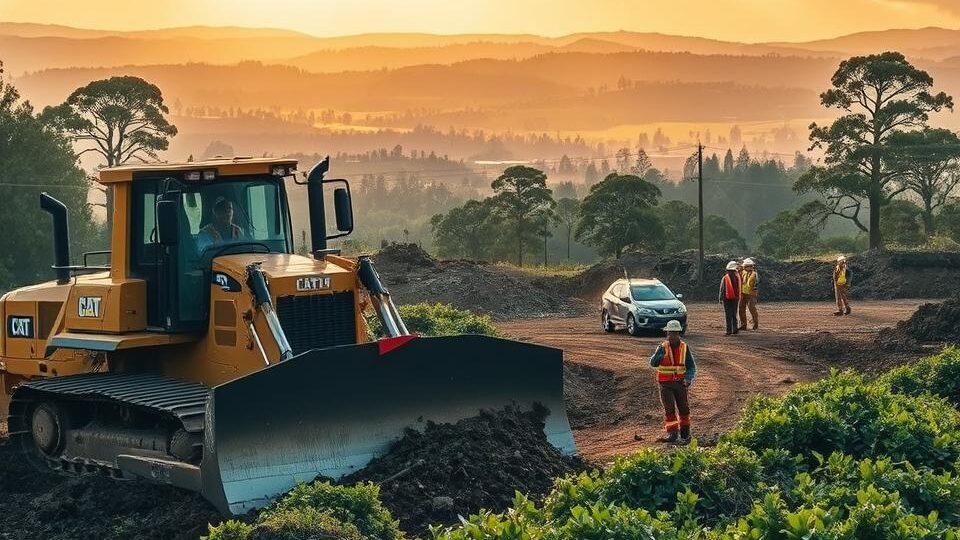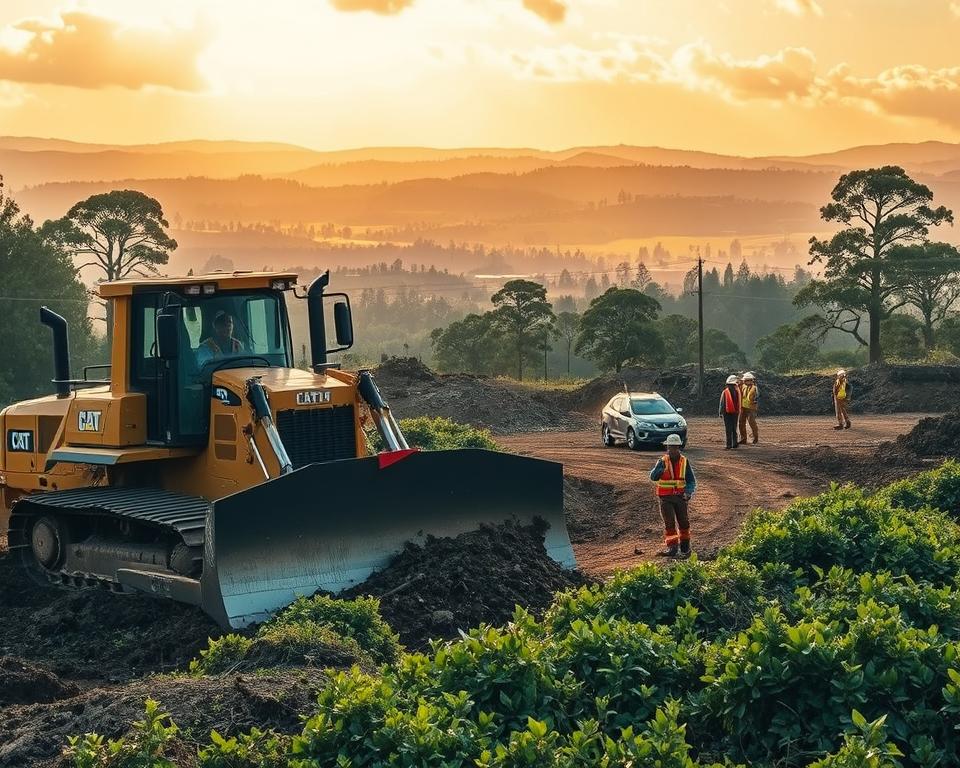
Preparing for Agriculture: Land Clearing Services for Meridian Farmland
Land Clearing Surrounding Water Sources: Prime Practices
Have you heard that nearly seventy percent of the earth’s fresh water supplies are threatened by farm runoff and Land Clearing? This alarming fact highlights the pressing requirement for responsible land management, essential during water source Land Clearing. Maintaining environmental responsibility is central to upholding ecological balance and protecting water quality and faunal habitats. With increasing resource demands from communities, embracing sustainable land management practices is essential. This approach promotes project success while mitigating soil erosion and minimizing pollution threats in aquatic ecosystems – land clearing.
Key Takeaways
- Green land management is vital for preserving water quality.
- Implementing best practices can prevent soil erosion and habitat loss.
- Understanding ecological impacts is essential for responsible Land Clearing.
- Proper planning enhances project success while safeguarding ecosystems.
- Utilizing effective techniques promotes biodiversity in aquatic landscapes.
Grasping the Significance of Sustainable Land Clearing
Land Clearing involves more than just uprooting vegetation. It has ecological effects of Land Clearing that can damage surrounding regions, especially those near water. Conventional approaches typically lead to soil erosion, habitat disruption, and water contamination. Recognizing these impacts is essential for embracing superior land management.
Environmental Consequences of Typical Land Clearing
Standard Land Clearing methods can cause many environmental issues. Soil erosion happens when vegetation is lost, degrading soil and causing sediment runoff into water. This runoff can pollute water bodies, harming aquatic ecosystems. This process puts local wildlife at risk and disturbs ecosystem balance.
Eco-friendly Land Management Alternatives
Adopting sustainable land management practices offers a solution to traditional clearing’s problems. Targeted clearing of select plants sustains ecosystem stability. Using erosion control measures, like cover crops, stabilizes soil and protects water quality. Emphasizing indigenous vegetation bolsters wildlife and fosters ecological well-being.
Essential Best Practices for Land Clearing
Successful Land Clearing starts with a deep understanding of environmental factors. It’s vital to assess environmental goals to ensure clearing efforts are effective and sustainable. By setting clear objectives, landowners can make decisions that balance environmental preservation with development needs.

Assessing Your Environmental Goals
Before a clearing project, one must appraise environmental goals. It requires examining the local ecosystem and clearing’s potential impacts on fauna, soils, and water. Defining personal objectives aids in crafting strategies to safeguard local habitats and watersheds.
Timing Your Clearing Efforts
The timing of Land Clearing is key to its success. Clearing during winter or early spring—when soils are frozen—minimizes disturbance and erosion. Avoiding clearing at wrong times promotes healthier terrains and reduces ecological harm.
Understanding Local Clearing Regulations
Following local Land Clearing regulations is necessary for successful projects. Understanding permit requirements can avoid legal issues or fines. It’s wise to check local ordinances, even near protected areas, to avoid environmental disasters from unapproved clearing.
Land Clearing Adjacent to Aquatic Points: Top Methods
Effective Land Clearing practices around water sources focus on protecting sensitive areas while ensuring ecological balance. A thorough approach involves identifying regions that require special care and implementing appropriate erosion control methods. Such actions are vital to conserving biodiversity and water quality.
Recognizing Zones Requiring Protection
Before clearing begins, identifying sensitive areas, such as wetlands and riparian buffers, is vital. These zones act as natural filters and refuges for multiple species. By properly identifying these areas, land managers can devise strategies for protecting sensitive areas during and after the clearing process.
Implementing Erosion Control Measures
Once sensitive areas have been identified, effective erosion control methods must be employed to minimize sediment runoff into adjacent water bodies. Methods like silt fences, vegetative buffers, and cover cropping are key to preserving water purity. Combining sustainable clearing and erosion controls promotes a robust ecosystem near water sources. This ultimately benefits both the environment and local communities.
Comparing Mechanical and Manual Clearing
Selecting mechanical or manual clearing is important. Both methods present benefits and drawbacks affecting ecosystems and operational efficiency. Understanding these differences helps landowners make informed decisions, aligning with their land management goals.
Pros and Cons of Mechanical Clearing
Mechanical clearing uses heavy equipment for rapid removal of vegetation and debris. This method accelerates projects and lowers labor demands. Nevertheless, machinery can disrupt soils, compact earth, and negatively impact ecosystems.
- Pros: Efficiency in clearing large areas.
- Reduced labor costs.
- Suitability for challenging terrains.
- Cons: Heightened environmental footprint.
- Potential for soil erosion.
- Risk of habitat destruction.
Advantages of Manual and Selective Clearing
Manual and targeted clearing emphasize eco-sustainability. They use skilled labor for targeted removal, minimizing soil disturbance and preserving plant species. Such practices are preferred for biodiversity conservation and ecosystem well-being.
- Benefits: Conservation of indigenous plants.
- Lowered soil disturbance and erosion rates.
- Enhanced habitat protection for wildlife.
Wetland Land Clearing Practices
Wetlands are unique zones essential for ecological equilibrium. They cleanse water, moderate floods, and support various plant and animal species. Grasping wetland ecology is critical for responsible clearing. The aim is to reduce disturbances and protect these crucial aquatic zones.
Understanding Wetland Ecosystems
Wetland ecosystems are characterized by their unique hydrology, soil types, and vegetation. They act as interfaces between land and water, sheltering multiple species. These ecosystems are essential for water quality regulation, providing natural filtration processes that remove pollutants. Preserving their integrity contributes to overall biodiversity and ecological resilience.
Methods for Eco-friendly Wetland Clearing
Responsible wetland clearing requires careful planning and execution. Sustainable methods can reduce the adverse effects of clearing. Some commonly adopted strategies include:
- Staging Operations: Conduct clearing in phases to minimize ecological disruption, allowing time for wildlife to adapt.
- Selective Clearing: Remove only specific vegetation types, preserving critical species for habitat stability.
- Encouraging Regrowth: Introduce practices that encourage natural vegetation regrowth after clearing, maintaining ecosystem functions.
- Buffer Zones: Establish buffer areas around sensitive wetland sections to protect aquatic habitats from disturbances.
Using these methods guarantees that wetland clearing respects wetland functions and decreases habitat loss risk.
Safeguarding Riparian Reserves in Clearing
Riparian reserves are crucial for healthy water ecosystems. These areas, located alongside rivers and streams, act as natural buffers. They safeguard water quality and enhance biodiversity. By adopting best practices, land managers can prevent erosion, protect wildlife habitats, and preserve waterway ecological integrity.
Role of Riparian Buffers in Aquatic Ecosystems
Riparian buffers are key to supporting aquatic ecosystems. They filter pollutants, stabilize shorelines, and provide habitats for various species. They serve as barriers that lessen human impact on aquatic systems. Preserving these zones boosts water quality and supports fish and aquatic life, enhancing ecosystem resilience.
Riparian Zone Management Tips
Key practices for riparian zone care include:
- Avoid construction within buffer strips to minimize disturbance.
- Use native vegetation to stabilize banks and prevent erosion.
- Establish a diverse plant community to enhance habitat complexity and support wildlife.
- Manage invasive species to protect native plants and maintain ecosystem stability.
- Regularly assess soil health and water quality to guide management efforts.
Significance of Aquatic Land Clearing Strategies
Aquatic clearing strategies help maintain ecosystem harmony and water quality. Managing water quality effectively during clearing minimizes pollution risks and supports sustainability. These approaches mitigate sedimentation and enhance aquatic ecosystem health.
Assessing Water Quality and Sediment Management
Effective water quality management starts with assessing local water bodies. Land clearing near these areas must prevent sedimentation, which harms water quality and aquatic life. Strategies include:
- Establishing buffer zones to filter pollutants
- Using sediment traps and barriers to minimize runoff
- Selecting clearing times to coincide with low water levels
These methods protect water quality and maintain ecosystem integrity. Residual vegetation aids in sediment control and nutrient cycling, leading to healthier waterways.
Aquatic Biodiversity Protection
Maintaining biodiversity in aquatic landscapes is key for resilient ecosystems. Aquatic land clearing should preserve native species, which are vital for these habitats. Steps to boost biodiversity include:
- Conserving critical habitats during clearing processes
- Implementing phased clearing to allow wildlife adaptation
- Restoring natural vegetation post-clearing to enhance habitat
Using these approaches helps land managers cultivate biodiversity in aquatic zones. This leads to more robust and adaptable ecosystems. Such measures defend water quality and encourage sustainable land management.
Stream Bank and Riverbank Clearing Considerations
Stream bank clearing comes with its own set of challenges, needing a focus on environmental impacts and regulatory compliance. It’s essential to ensure the process respects riverbank considerations to preserve water sources’ ecological balance. Addressing erosion, habitat disruption, and water contamination requires targeted solutions.
Obstacles in Stream Bank Clearing
Clearing stream banks encounters multiple obstacles. Erosion is a major concern, causing soil loss and water quality deterioration. Disturbing habitats affects wildlife reliant on riparian areas. Lacking vegetation, stormwater flow intensifies, causing sediment buildup in streams. These issues highlight the need for effective management of stream bank areas.
Combatting Erosion and Promoting Healthy Flora
Mitigating erosion is key for stream bank clearing. Using indigenous vegetation fortifies banks. Their roots combat soil erosion, fostering a sustainable environment for local flora and fauna. Ongoing evaluations during clearing verify method effectiveness, aligning practices with riverbank protection. Lush vegetation advances management objectives and sustains ecosystem health.
The Final Word
Implementing the best practices for Land Clearing around water sources is essential for maintaining ecosystem health. Stakeholders should emphasize sustainable land management. This approach not only fulfills their goals but also protects the environment. Thoughtful planning and execution guarantee that clearing preserves aquatic ecosystems and biodiversity.
Spotting vulnerable areas and employing erosion measures are crucial steps. Using mechanical and manual methods enables landowners and contractors to practice responsible land management. Green practices encourage co-existence of human operations and natural systems. This maintains vibrant, resilient water sources and adjoining landscapes.
Sustainable land management demands collective commitment. Each clearing activity influences watershed health. By integrating environmentally responsible practices, we can create a future where agriculture and the environment coexist harmoniously.